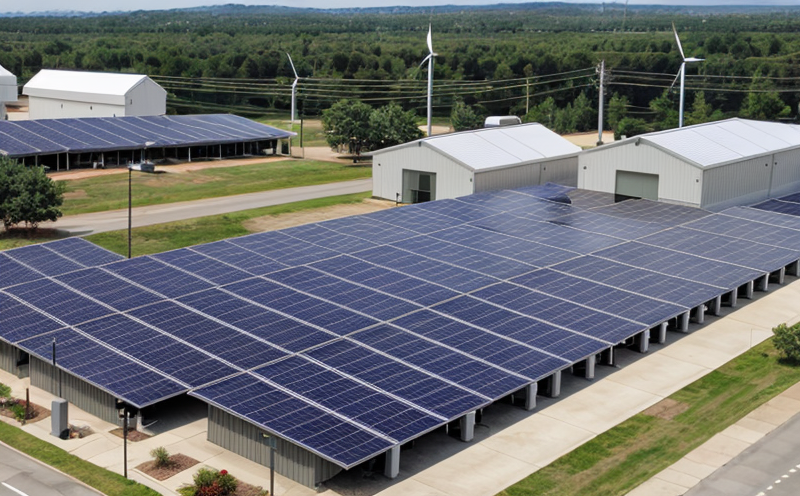IEC 61000-3-2 Harmonics Emission Testing in Microgrids
Microgrids have become a critical component of modern energy systems, providing local power generation and distribution that can operate independently or in conjunction with the main grid. These systems are designed to enhance reliability, efficiency, and sustainability by integrating renewable energy sources such as solar panels, wind turbines, and battery storage.
The International Electrotechnical Commission (IEC) has developed standards like IEC 61000-3-2 to ensure that the harmonics generated by these systems do not interfere with other electrical equipment. This standard specifies limits and methods for the measurement of voltage and current total harmonic distortion (VTHD and ITHD) in power distribution networks, which is especially crucial for microgrids.
The testing process involves measuring the harmonic emissions at various points within the microgrid to ensure compliance with these standards. This can include monitoring the harmonics generated by individual components like inverters, transformers, and capacitors. By adhering to IEC 61000-3-2, microgrids can minimize their impact on the grid, improve power quality, and enhance overall reliability.
The testing process typically begins with a thorough site survey of the microgrid infrastructure. This includes identifying all potential sources of harmonic emissions and mapping out the network topology. Once this information is gathered, specialized equipment is used to measure voltage and current at strategic points throughout the system.
Harmonic distortion can be particularly challenging in microgrids due to their interconnected nature and variable power sources. The testing process must account for these factors by using advanced instrumentation capable of capturing transient events and steady-state conditions. This ensures that any anomalies or deviations from standard limits are detected early and addressed promptly.
The results of the harmonic emission tests are then analyzed against IEC 61000-3-2 requirements to determine compliance. Non-compliance may indicate issues with individual components, improper installation practices, or operational inefficiencies within the microgrid. In such cases, corrective actions can be implemented to bring the system into alignment with international standards.
By ensuring compliance with IEC 61000-3-2, microgrids not only meet regulatory requirements but also contribute positively to environmental sustainability goals by reducing energy losses and promoting cleaner power generation. This testing process is an essential part of maintaining a robust and reliable energy infrastructure that supports both grid stability and the integration of renewable energy resources.
Applied Standards
| Standard | Description |
|---|---|
| IEC 61000-3-2 | Harmonics and interharmonics in public power supply – Part 3-2: Limit values and measurement techniques for voltage total harmonic distortion (VTHD) and current total harmonic distortion (ITHD) at supply points of interest. |
| IEEE P1547 | Recommended Practice for Utility Interface for Distributed Resources. |
| Standard | Description |
|---|---|
| EN 50160 | Electricity Quality – Voltage characteristics at the point of common coupling between a power system and a customer or a group of customers. |
| ASTM E983 | Standard Test Method for Harmonic Analysis in AC Systems Using Power Line Carriers. |
International Acceptance and Recognition
The standards developed by the IEC, including IEC 61000-3-2, are widely recognized and accepted globally. They provide a common framework for testing and ensuring compliance with international best practices in power quality.
IEC standards such as these have gained traction due to their ability to harmonize technical requirements across different countries and regions, making it easier for manufacturers and suppliers of equipment used in microgrids to meet regulatory expectations. The consistent application of IEC 61000-3-2 ensures that all parties involved understand the specific parameters they need to address when designing, manufacturing, or operating a microgrid.
Compliance with these standards also facilitates smoother international trade by ensuring that products and services are compatible with local regulations. This is particularly important for companies operating in multiple markets where different national standards might otherwise complicate compliance efforts.
The widespread adoption of IEC 61000-3-2 has not only enhanced the reliability and efficiency of microgrids but also contributed to broader sustainability goals by promoting cleaner energy sources. By adhering to these international standards, organizations can demonstrate their commitment to responsible environmental stewardship while maintaining high levels of technical proficiency.
Environmental and Sustainability Contributions
The testing of harmonic emissions in microgrids according to IEC 61000-3-2 plays a vital role in supporting broader sustainability objectives. By minimizing harmonic distortion, this testing helps reduce energy losses within the grid, which translates into lower greenhouse gas emissions and reduced operational costs for end-users.
Harmonic distortion can lead to increased heating in transformers and other electrical equipment due to inefficient power flow. Reducing these distortions through rigorous testing ensures that microgrids operate at peak efficiency, thereby extending the lifespan of critical infrastructure components. This longevity reduces the need for frequent replacements or upgrades, further contributing to resource conservation.
In addition to enhancing operational performance, compliant harmonic emission testing supports the integration of renewable energy sources into existing grids. As more intermittent power generation technologies like solar PV and wind farms become prevalent, maintaining stable voltage levels across interconnected systems becomes increasingly important. By ensuring that microgrids meet IEC 61000-3-2 requirements, utilities can better accommodate these variable inputs without compromising grid stability.
The focus on minimizing harmonic emissions also contributes to improved air quality by reducing the load on fossil fuel-based power plants. As renewable energy technologies continue to grow in importance, their successful deployment depends heavily on robust and reliable microgrid infrastructure capable of handling diverse energy sources while maintaining high standards of electrical integrity.





